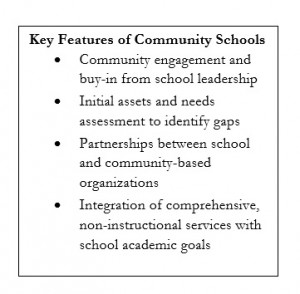Public schools are an ideal place to deliver services — beyond the classroom — to low-income children and their families. One type of program, the “Community Schools” model, uses schools as central hubs for students and the larger community to access services such as physical and mental health care, afterschool programs, adult education, or early childhood supports. Schools and community-based organizations partner to deliver services identified as community priorities. Over time, these services can lead to engaged families, stron ger communities, and better academic outcomes for students.
ger communities, and better academic outcomes for students.
The District currently is investing resources into six partnerships, involving 11 DC schools, to broaden their role in their communities, but it could be doing more to expand these promising practices to all high-poverty schools. As part of our Unlocking Opportunities series, DCFPI discusses how Community Schools work, the benefits of delivering services in or near schools, and describes some of the lessons learned from the Baltimore Community Schools initiative. Our recommendations for DC are:
- Create clear, stable funding for the Community Schools model to expand in the District. Community Schools should be prioritized and funded as part of strategies to close the student achievement gap in DC.
- Explore the role of an intermediary organization. An agency — either government or non-government — should take on the role of coordinating a city-wide expansion of Community Schools, including consistent tracking of program participation and outcomes, and making professional development and technical assistance available for grantees.
- Prioritize data collection and evaluation of key indicators. The District should collect information on school readiness, student attendance, adult education, and other indicators to assess the short- and long-term impacts of Community Schools.
For the complete brief on Community Schools, please see here.
To print a copy of today’s blog, click here.
